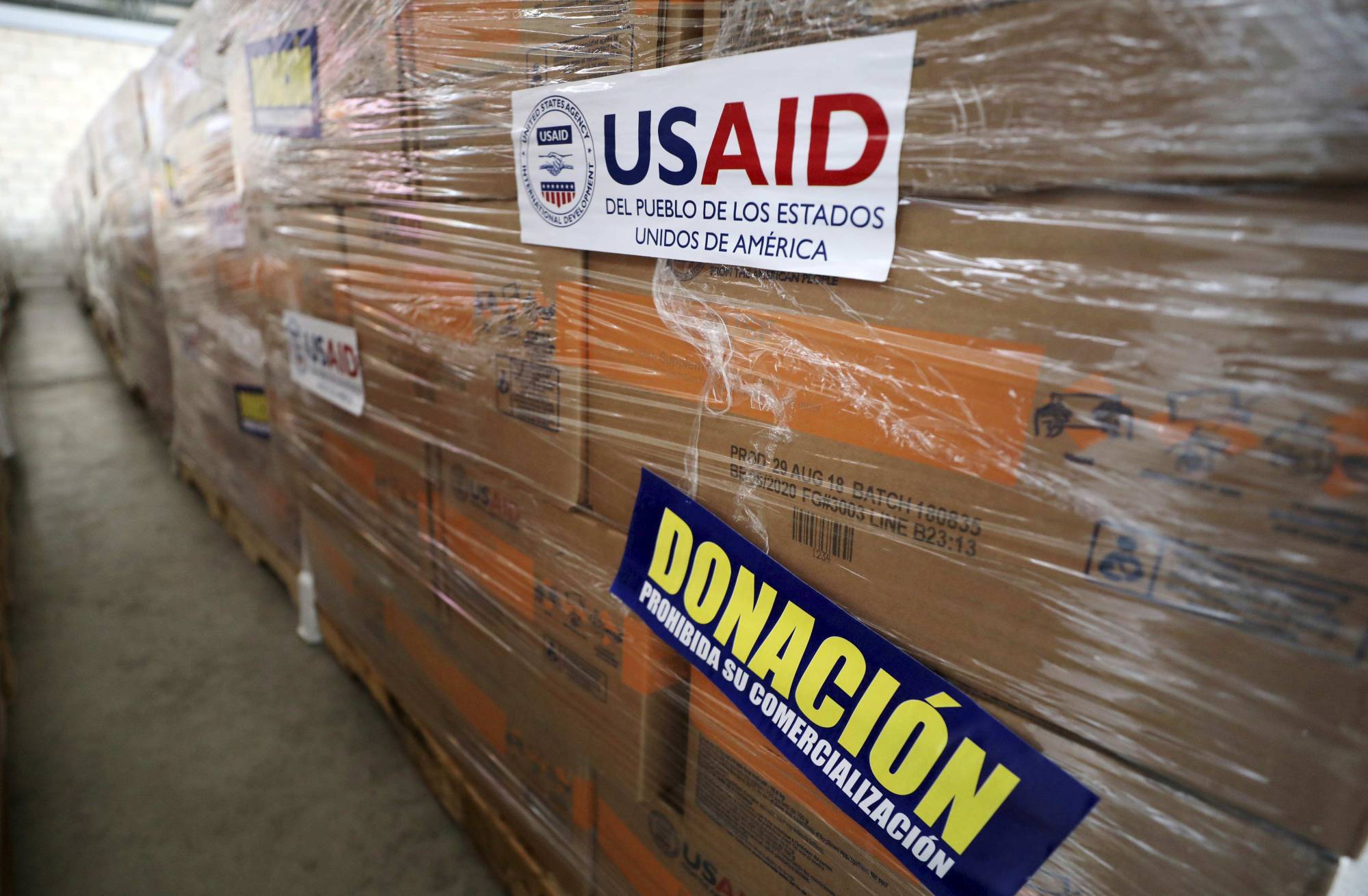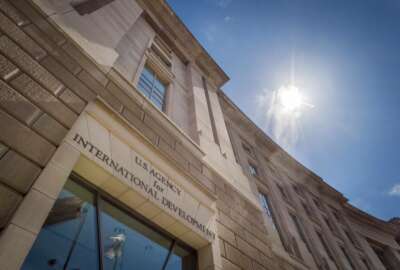USAID creates a new position to oversee digital technologies
There's a new position at the U.S. Agency for International Development. It's called the Chief Digital Development Officer.
Best listening experience is on Chrome, Firefox or Safari. Subscribe to Federal Drive’s daily audio interviews on Apple Podcasts or PodcastOne.
There’s a new position at the U.S. Agency for International Development. It’s called the chief digital development officer. For what the job is all about and why, we’ve got the guy who holds it. Christopher Burns joined the Federal Drive with Tom Temin to discuss.
Interview transcript:
Tom Temin: Mr. Burns. Good to have you on.
Christopher Burns: Great to be here, Tom, thanks for the opportunity to chat today.
Tom Temin: So Are you new to USAID in this job? Or is this something they’ve added to your duties, or have you switched offices?
Christopher Burns: It’s a new area of responsibility for me. I’ve been with AID for just over 12 years now. And during that time, I’ve had the incredible opportunity of building USAID’s digital development practice from start. It began back in 2011, when I designed the first multi-stakeholder partnership focused on mobile phone technology at the time, and that was focused on closing the gender digital divide, that had just been identified in the developing world. And from that moment, I’ve been able to be along the journey of what is now the Technology Division in the Bureau for Development, Democracy and Innovation in our Innovation, Technology and Research Hub. So I hold the position of director for technology. And now in addition to that, the chief digital development officer.
Tom Temin: All right, let’s begin then a little bit earlier, and that is digital development. What is that in the aid context?
Christopher Burns: Sure, digital development is a way of acknowledging that business has changed in the field of international development and humanitarian assistance. And we want to make sure that in our programming, we are fostering an open, inclusive and secure digital ecosystem in countries where we work around the world. We really want to make sure that in particular underserved and marginalized communities can access digital technologies and maximize them for their socioeconomic and livelihood needs.
Tom Temin: Well, how does that take form? Many years ago, there was a gambit to have the $100 laptop, you may remember that. That goes back a couple of decades now, to put some kind of a digital means in every person’s hands that could not afford it otherwise. How does this take form now in the smartphone era, in the cellular era?
Christopher Burns: Right, we have learned a lot from one laptop per child from back in the day. And I think, right and when that was coming online is when we were switching from this idea of ICT for D so information and communication technology for developments to digital development. I think back in the day, digital technology was treated more as an add on and something to think about after a program was designed. Digital development kind of flips that on its head to say when you’re designing any program across any sector, be it health, economic growth, education, food security, identifying how digital technologies are going to help us achieve the objectives of that work from the beginning. And also thinking about the role of data in driving better decision making strategic planning and adaptive programming, and the role that digital technologies actually allow us to be a more data driven organization. And so the whole rubric has shifted a lot since those days. And a lot of that is embedded in the first ever USAID digital strategy that we released in April 2020. And I’d be happy to share a little bit more about that strategy. If that’s of interest to you, Tom.
Tom Temin: Yeah, but first, give us an example of what a digital program might look like for distributing aid. I mean, USAID funds organizations that are generally indigenous to the country you’re working in. So there’s several parties involved here. And then there’s the ultimate aid recipients. What does a digital effort looked like in that context?
Christopher Burns: Yeah, I could point to a lot of examples. In some cases, it’s focused exclusively on those digital technologies and others, it’s more sectoral effort that has a digital component as an enabler. But I think the best example that I could share with you is what we did in post Ebola West Africa, particularly in Liberia, where we recognized as they were trying to mitigate the health crisis there that it was really hard to get information out to the field and track patient zero and have health workers on the ground be able to do their work. And so once Ebola was no longer a serious crisis, we did a number of things. We partnered with a Google local affiliate called CSquared. And we built a fiber ring around Monrovia, almost 200 kilometers of fiber, and then connected a lot of the line ministries and the internet service providers to that fiber. We also brought in a two-way mobile communications platform that is called mHero that allows the Ministry of Health to engage with frontline health workers and share real time information. That platform is still being used today in the context of COVID-19. And we also introduced mobile money into the country so that health workers and teachers can get paid without having to leave their communities and travel long distances to banks. So it gives you an idea of it’s all about driving greater efficiencies and more effectiveness in what we’re doing our development work with the introduction of these digital tools and technologies.
Tom Temin: We’re speaking with Christopher Burns. He’s the first ever chief digital development officer at USAID. And a moment ago, you mentioned the digital strategy, maybe just give us a broad overview of what that is and how these projects fit in with it.
Christopher Burns: So the strategy was released in April 2020. It’s the first of its kind for USAID. And it really charts an agency-wide approach to international development in what is a rapidly evolving digital age. It’s got two mutually reinforcing objectives. One is to improve development in humanitarian assistance outcomes through the responsible use of digital technology and our programming. And the other is to strengthen the openness, inclusiveness and security of country digital ecosystems themselves. And you really can’t do one without the other, we would posit. The strategy itself called for the establishment of a senior level digital development position to coordinate digital program initiatives across the agency, and to ensure synergies and consistent approaches in those initiatives, both within the inner agency and with external partners. So in late November, last year, AID designated me as the first chief digital development officer, and there’s a couple things that it requires me to do, if you want me to outline those.
Tom Temin: Well, are you a techie? Or are you a development and aid distribution expert that uses techies to help you build what it is that you need to deliver services and aid digitally?
Christopher Burns: Yeah, that’s a fun question. I am not a techie. I am an international development practitioner with more than 25 years of experience and a couple of degrees on that topic. And I’ve worked in the field and lived in West Africa for seven and a half years, for example. But it was really in West Africa, when I was the programming training officer for Peace Corps in Niger from 2006 to 2009 effectively, like the deputy country director, where I really saw the utility of digital technology in development work. In that position, a lot of our Peace Corps volunteers were doing a lot of radio broadcasting in local languages, where they would do it on different themes, such as forestry, or agricultural management or education. And they were really like local celebrities when they broadcast those programs, and then go around their towns and have dialogue with folks. And it struck me, it was right around the time that the mobile phone was just coming online in Niger. And radio is such a brilliant form of communication, Tom, you know so well, and getting messages out there, but not as effective in understanding if those messages have been received or understood or if there has been a behavior change associated with it. So the mobile phone that was introduced was really my aha moment saying, wow, this is where we can definitely do development more effectively. And I really see it as like that grand, great enabler, particularly for underserved communities, to engage with governments, to engage with one another, and to start driving real change in development.
Tom Temin: And if you’re working in, say, a health project or a food project, I mean, that’s what you do is help with the basics that people need in these places. And is it necessary for the ultimate recipient of that vaccine if that’s the case, or of that bag of rice if that’s the case to be digitally connected? Or does it only need to extend as far as the local agent or grantee on behalf of USAID to be digitally equipped?
Christopher Burns: Well, I suppose part of the response to that question is, who are we in service to? If the ultimate goal is to foster economic growth and empowerment and opportunity for the end user, and we look at it at a community level and even at an individual level, then I would say yes, they need to be empowered enough to be able to effectively manage their mobile device or internet connection, to have the right digital literacy and capacity to engage online safely, to understand perhaps the importance of data privacy, and how to mitigate cyber threats to them, particularly for folks coming online. And really want to make sure that everyone equally can have access to that. And you’re right. We look at our work oftentimes at a sectoral level, right, and humanitarian assistance, getting food aid out to someone or in agricultural programming, making sure that smallholder farmers have the information that they need to make informed decisions, or in digital health, as you noticed, making sure that we are offering the services to the end users such as what a digital birth certificate might afford them in granting access to public sector social service delivery. And so you can think across that gambit and try to recognize that in health, for example, where do low cost sensors come in so that farmers can understand what’s going on on their farm and get that tailored, customized information based on their needs, not some generalized message that goes out to them. Or in health delivery, what is the role of digital identity in biometrics so that families can have access to the services they need in a way that ensures privacy and security.
Tom Temin: So if you get away from humanitarian direct aid, which sometimes happens, but look at more of the, as you put it, sectoral development challenges, like better agriculture, or better health care delivery, it sounds like you don’t want to help a nation develop its agricultural capacity and talent to the 1970 level, but rather to the 2022 level. And if you look at the most productive and most advanced farming techniques in the world, in places like the United States and Europe, there’s a lot of digital stuff that goes on for high yield farming and efficient farming. Is that a good way to put it?
Christopher Burns: That’s a great way to put it. And I think using the example of precision agriculture in the U.S. and in North America is the right way to approach it, right? A lot of folks are looking at IoT enabled tractors and machinery, equipment, and how do you drive the big data behind that to make better informed decisions? I mean, there’s a reason why all the big ag companies are buying hand over fist, data analytics firms. It’s a sustainable business model, but it’s also setting themselves up for success tomorrow. There’s no reason that smallholder farmers in sub-Saharan Africa or Southeast Asia need to wait for that moment, right, there’s a lot of opportunity to employ data informed decision making on their fields, so that they can be more productive, so they can have stronger access to markets, and so that they can build the economic growth of their families.
Tom Temin: We’re speaking with Christopher Burns, he’s the first ever chief digital development officer at USAID. And from the internal standpoint of the agency, as the chief digital development officer, do you also work with the digital people that do IT, and the data officers and that whole panoply of people that might be developing, you know, the systems to run finance for USAID, but it’s the same technologies.
Christopher Burns: It is a lot of that remit lies with our chief information officer and chief data officer and others, which we liaise with closely. Our focus is at the programmatic side. So in country, and not operationally. We are not in the business of building things as much as we are in the business of ensuring that the approaches are done in a right way.
Say, for example, the growing use of artificial intelligence, right? We have a brilliant team within my division who tries to understand its utility to the field of international development. And to make sure that the entrepreneurs in country who are employing AI and machine learning and the innovators in country, or the implementing partners who are delivering our programs are employing AI responsibly and ethically, right? Making sure that protections are in place.
Now in some cases, we have programs like through our development, innovation ventures that go out and solicit new ideas at a country level. And those new businesses there might be building artificial intelligence, or they might be pulling from off the shelf programs to deploy. And we want to make sure that they’re doing it the right way. So to give you a flavor of the type of work we do, we have something called Principles for Digital Development. These are nine best practices that USAID co-developed in 2015, to say, if you’re going to introduce any digital technology into a program, let’s do it the right way, let’s make sure that it’s designed with the user in mind. That it’s built for sustainability and scale, that it has protections in place. And there are now over 300 endorsers of those principles, governments, private sector, civil society, academia who said, yes, we believe that we need to do this, we need to make sure that we are not redundant in our digital investments, that we’re not tripping over one another, that we are deploying them in the right way to meet our overall objectives. And so our team takes forward that body of work and make sure that actors on the ground, understand how to deploy them accordingly.
Tom Temin: So to put it another way, then you are not only exporting the development activity itself, but in some sense, exporting the technological sophistication needed to do those sector things in those other nations at a high level.
Christopher Burns: In some cases, sure. We do partner with the private sector and technology companies here in the U.S. for example. We’ve got a couple of partnerships that we just rolled out with Mastercard on driving digital financial services, particularly for women led businesses. We’ve got a partnership that we just launched with the Mozilla Foundation to build ethical and responsible practices into those who code around the world. We have a couple partnerships with Microsoft, as well. And in some cases, we are taking those technologies and sharing them in communities where we work. But we’re also capitalizing on the great ingenuity that is coming from countries where we work themselves, where you have an incredible bunch of local talent, who is designing technology and approaches that is really fit for purpose and really takes into account local needs. As one quick data point, if you look across Africa alone, there are over 600 innovation hubs and incubators where you have local talent, oftentimes young Africans who are coming together in understanding their local communities and building those technologies that really speak to what they want to see.
Tom Temin: Christopher Burns is the first ever chief digital development officer at the U.S. Agency for International Development. Thanks so much for joining me.
Christopher Burns: Thank you, Tom. Hope you have a great day.
Copyright © 2025 Federal News Network. All rights reserved. This website is not intended for users located within the European Economic Area.
Tom Temin is host of the Federal Drive and has been providing insight on federal technology and management issues for more than 30 years.
Follow @tteminWFED






